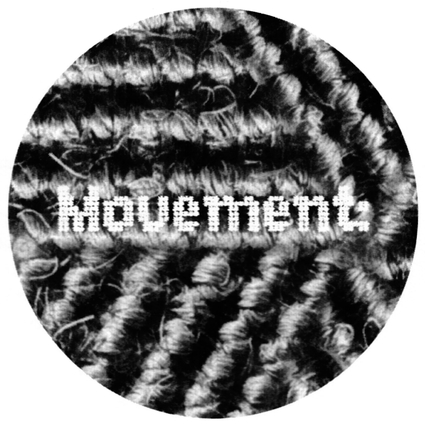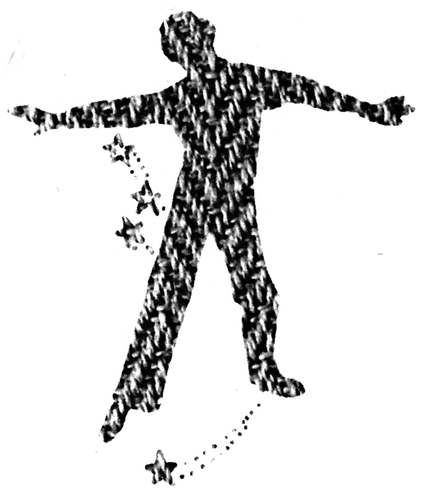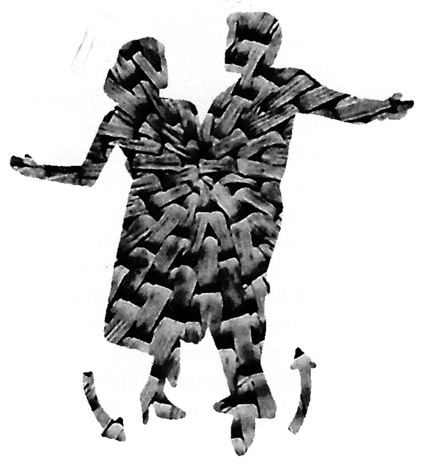As soon as one wants to obtain 'knowledge' about society and its pervasive signal economy, one is usually asked by some killjoy: how can you reach any conclusion about the signal-spaces you are moving in while you're still moving there? 'Outside' the spheres, you are expected to justify your observations by marking the exact point where you found an exit that allowed you to get out and 'rise above' the trinity of visual space, acoustic space and tactile space (= society). Yet this divine point of view nobody ever successfully ascended to has now become a dump for the unwanted. People are beginning to feel and act 'completely out of it', especially in societies which have a high resolution image of themselves with clear definitions of what 'inside' or 'outside' means. Some time ago German writer Rainald Goetz wrote that it is not true that there is no place outside where critique as practice is exercised: the proper place is called youth. If this is still true, then protagonists of youth culture will have to get used to the idea that many will join them outside now, because misery loves company. This essay will delineate a certain practice, or rather a variety of practices, already found in the privileged indecision zone which lies in the yet unmarked space that shares its medium with both the inside and the outside, practices which I subsume under the term 'Ambient Entity' = AmbiEntity. An AmbiEntity is not something anybody could proudly call him/herself; only observers can decide whether a given space is inhabited by an AmbiEntity. Let's provide the means by which such a decision may be reached and explain the necessity of doing so.
Home - Living Room
The first distinction I should introduce is the symmetrical and polar one between 'homes' and 'Living Rooms'. Living Rooms are 'real' (empirical), homes are not (speculative). (Homes probably were real, too, at some point in the distant past, but this was before pop culture). Homes are 'origin stories' constructed as retrospective signposts within visual space, acoustic space, and even tactile space. They are made for coming from (as Lee Marvin sung, who was born under a wanderin' star). Living Rooms are 'rooms that live', rooms decorated and functionalized so as to immortalize the present and keep away the demands (pasts), thereby protecting the inhabitants from things that go bump in the night. When Living Rooms get mistaken for Homes, tragedy strikes. What you get then is called a prison. Prisons and Sanatoriums, although crammed with people, seem to be pretty vacant in the 90s: attractive, perhaps, to the completely demoralized. Home is the past while a Living Room might be 'History', and while history is societally conditioned and may be described as a tunnel through which an optional sense of being 'here' might be deduced, the past is not societally but ontologically conditioned and can have no tunnel function since it is, by its very definition, something that can only be 'accepted' or 'rejected' like a prison sentence.
A 'progressive' use of the Living Room is made by the AmbiEntity, who does not mistake Living Rooms for homes; instead it stalks those rooms (which move around in an otherwise slowly de-mobilizing society) like a hunter would stalk his/her prey. When a Living Room is caught by an AmbiEntity, it sometimes even gets killed.
The prime motivation for the AmbiEntity's hunt for Living Rooms is disappointment with pop culture: at some point in Minkowski spacetime, the AmbiEntity might have wanted to 'go underground'. But apartments near the hangouts of the underground had become too expensive. A new space, beneath the old underground, had to be found and conquered. To some, it was cyberspace. To others, it was Living Rooms. In searching for the Living Room, the AmbiEntity uses a mode of perception depending upon one single, enhanced sense: the sense of hearing. AmbiEntities dig sounds. After all, sounds initially motivated them to search for a different life, different from the one that was proposed by (real or imaginary) 'authorities'. The pop-hangover does not trigger despair but rather enlightenment: the former hopes were never 'bad', just unfulfilled; now it's time to move on. As German pop critic/liquid sociologist/holeopathic SubGenius Diedrich Diederichsen put it (in Spiegel Spezial: Pop und Politik, 1994): Pop music talks about social movement and mobility and in doing so knows primarily one direction: from the totally singularized state/exclusion of the individual (be it for political, `racial', or economic reasons, the result is being lonely, feeling strange, acting weird) to the utopian inclusion of all (liberation, revolution, unity, communication). Pop said hello, while you said goodbye - and pop was rather stupid sometimes in not even understanding why you said goodbye - it still said hello. That's why the AmbiEntity is so keen on listening to 'Ghetto Music' (as rapper KRS-1 dubbed it on his album Ghetto Music - the blueprint of HipHop). Pop never pretended to make a new society real, but instead dealt with improbabilities and made the old society unreal. Famous folk singer and convicted criminal Charles Manson used to demand: Cease to exist! But that's no way to become an AmbiEntity, and Manson is in prison and cannot give us any advice. The Living Room hosts options: it is imperative that one could always leave it, yet never gets around to actually do so. If one stays because one simply cannot leave, the Living Room dies.
Repetition and Difference
A little-known person named Charles H. Duell could be called one of the main ancestors of the AmbiEntity. He was Commissioner of the US Patent Office at the turn of the last century. In 1899 he implored US President William McKinley to abolish the Patent Office and stop handing out patents to inventors, because, as Duell reasoned brilliantly: Everything that can be invented already has been invented. The only thing that Duell's very workable worldview lacked to make him a complete and proper AmbiEntity was the subtle understanding of the intertwining play betwixt difference and repetition that 15-year old technokids of our time have since achieved. Clarity obscured Duell's view. He was correct: everything worth inventing had already been invented, but there were ways of using the equipment the wrong way which still had to be figured out.
In an article for the German semi-professional technofanzine Raveline (#4/1994), a young dude named Marcel Feige describes the slings and arrows of outrageous fortune that 1994's kids have to suffer and endure under conditions anticipated by Duell - they have to grow up thinking everything has already happened (Gina Arnold, Route 666 - The Road to Nirvana ): Off to town with my brother. In the car, I put Westbam's Mix Tape, which I acquired for 50 marks, in the tape deck, I'm proud to own this tape, but oh, what Horror: five minutes later, my brother asks:// Is this a new song already or is it still the same? I throw the barbarian out of the car and hop off myself at the local record store. (...) Finally, Saturday, almost 7 PM - I lie in the bathtub to wash away the dry sweat from last night's party, getting ready for tonight's Rave. I can't listen to music in the bathroom. I still remember my mother's evil glance the day I pumped up the Volume of our Living Room's Stereo to hear every last 303-Sequence of that ForceMassMotion in the bathroom. Gotta hurry. (...) I sink down into the water and the water gets into my ears, my mouth forms a silent O and I push my breath out of my lungs in short intervals. A Mega-Bassline forms in my hide. I could spend all evening like that. I just need a tape deck now to sing a perfect demo. The attitude young Marcel describes here may not be the most advanced way to get a grip but at least it gets you through the night. It's quite ahistorical and yet not existentialist. The key sentence is where the brother is denounced for not understanding the significance of a music where 'all the tracks sound the same'; the aforementioned Diederichsen once stated that a truly new music is easily recognized by seeming to lack variety. The idea is to feel insistence in the distance: repetition and difference played off each other. For a good introduction to the issue of how marginalized cultural practice works with repetition patterns, compare James A. Snead's 'Repetition as a Figure of Black Culture' in Ferguson/Gever/ Minh-ha/West: Out There: Marginalization and Contemporary Cultures //(Cambridge, MA, MIT Press, 1990).
Urban techno and hiphop kids live in a situation similar to Jeffty's - Jeffty was the protagonist of a 1977 short story by American speculative fiction author Harlan Ellison, 'Jeffty is Five'. Little Jeffty was blessed - or cursed - with the ability to stay 5 years old all his life - he could listen to new episodes of old, forgotten radio shows on his old radio, although those shows did not exist anymore and those new episodes were never produced. When you have to grow up thinking everything has already happened, you become 'Jeffty' in a way. Ellison wrote: Hume denied the existence of an absolute space, in which each thing has its place; Borges denies the existence of one single time, in which all events are linked. Jeffty received radio programs from a place that could not, in logic, in the natural scheme of the space-time universe as conceived by Einstein, exist. But that wasn't all he received. He got mail order premiums that no one was manufacturing. He read comic books that had been defunct for three decades. He saw movies with actors who had been dead for twenty years. He was the receiving terminal for endless joys and pleasures of the past that the world had dropped along the way. (Ellison: 'Jeffty is Five', in The Essential Ellison (Beverly Hills: Morpheus International, 1991), p. 805) Jeffty's cousin, the AmbiEntity, does not move at all. Authentic, genuine movement from A to B would only disturb the Living Room and interfere with the Living Room's self-reproduction/self-maintenance/self-preservation.
Circular Movement
Both biologists of the Maturana/Varela school and advanced sociologists of the Niklas Luhmann branch call these processes autopoeisis, although this does not imply simplistic analogies between organisms and social systems. How can an observer distinguish the AmbiEntity from the Living Room if the AmbiEntity does not make moves allowing such a distinction? The AmbiEntity finds a suitable substitute for movement, namely the 'movement that rests': circular movement. The power source of circular movement is a vast pool of both intentionally and accidentally produced arbitrary sound at the frayed ends of pop music.
Before there were BPM-numbers (beats per minute), RPM (rounds per minute) was indicated on record sleeves and labels, and the double heart of a tape went round and round to transport the music from A to B and back (!) again. Even a CD 'rotates'.
There are two kinds of beautiful circular pseudo-movement, one is autorotation, the other gets into orbit and circles around a world. Both run deep as undercurrents of western pop-culture and since about 1950 are frequently manifest in music.
1. The autorotation principle can be found in hi-energy-disco-music of the mid-80s (You spin me right round baby right round/ like a record baby round round round round, a beautiful song by Dead or Alive) as well as on a cosmic scale, where teleschizomatic fuzzrock-ecosystems rotate and spin in ageless foolish hippie wisdom (To everything/ turn turn turn/ there is a season/ turn turn turn....) This autorotation principle invites introspective approaches and navel-gazing; its intellectual format would be woolgathering. When the autorotation principle combines with aggression, socially induced fear and tension, it becomes paranoid: the rotating 'identity' (an entity under the influence of what Freud called 'Id': an Id-Entity) looks for a direction in which hatred and fear might be released on guilty ones. This can be studied in the stage performance of W. Axl Rose, lead singer of Guns 'n' Roses. His act onstage is frequently that of somebody who feels he has to run amok among the ordinary citizens: he holds his microphone stand at a 90-degree angle away from his body, which becomes an axis for a weapon of destruction, while at the same time singing: I don't need your civil war. This is not a pacifist statement. He doesn't really say that civil wars are bad, he just says you can keep them for yourselves.
W. Axl Rose, who is thus perhaps more of a 'leader of the free world' than Clinton ever will be, recently expressed a morbid fascination with the fate of eternal prisoner Charles Manson, a fascination which is quite different from the strange solidarity with which American Punk Rock Legends like Henry Rollins (former lead singer of Black Flag, now a successful solo artist) always spoke of Manson. Henry Rollins' stage act is the exact opposite of Axl Rose's. As such, it's not necessarily 'better', but a difference that puts a mark on the situation as a whole. Rollins' muscular body, tattooed all over with underground-history's insignias (things like Manson's 'Creepy Crawl' symbol and the logo of Black Flag, one of the most important early 80s US punk bands between the Dead Kennedys and Minutemen), twists back and forth, becoming a Civil War all its own; sometimes it doesn't even look real, and that's because it's not - in 1994 Rollins declared he's a 'liar', and woe to those who claim to understand or identify with him. While Rose lashes out at invisible demons (meaning the poor huddled masses of the planet, no doubt) with his microphone stand, Rollins seems to take invisible punches from all sides, but all the beating he receives from out of nowhere only makes him stronger, a true 21st century Nietzschean autorotation transcendentalist, who has also invented lyrics to match that performance: I've been followed around again, around and around again (...) feeling like a lonely man choking on a telephone line/ tryin'so hard but I still can't lose my mind. The White Man's burden. This is where Rock's paranoia, the belief that Civil Wars are waged out there just to make it difficult for me to grow up, becomes supercharged information, beats gravity and soars off to the stars, which brings us to the orbital movement.
2. This second kind of circular movement was of course first illustrated by the last 20 minutes of Kubrick's movie 2001: A Space Odyssey, corresponding beautifully with the autorotation interior set shown earlier in the film in the famous 'jogging on the ceiling' scenes. Kubrick even thought of mentioning the necessary Minkowski-Space where those two circular movements, spindle/autorotation and orbital rotation, can take place. He visualized the Living Room showing us a clean Louis XVI bedroom bathed in white light. The fitting musical description of orbital movement was created by the Beatles in Lucy in the Sky with Diamonds. The orbital experience is encoded in countless pop and rock songs, from the Beach Boys' Round round get around I get around to Van Halen's Here we go around round/ run run runaround. If Guns `n Roses represent a 'worst-case-scenario' for the autorotation model, then it is safe to say that Mike Oldfield, some tracks by Ace of Base and almost all the Muzak work by Brian Eno represent the lowest common denominator to which 'orbital' approaches can sink.
The rare and confusing epiphanic moments where those two rotation blueprints become one, allowing synergistic perception, remain promising for things to come - listen to Chuck Berry's Round and Round for example, or some fine ambient/trance techno. What happens when a 'white' person living in Europe, or somebody who was born and raised in Tokyo, hears rap group Gang Starr's announcement that: Brooklyn, New York, is the best... the place where we dwell? The listeners don't know Brooklyn from experience, but then again, listening to music is an experience in its own right. There is the viszerale Erschütterungen (Diedrich Diederichsen) of course. Those sonic nervous identity earthquakes spiral the listener out of sync with her/his supposed environment. Adaption alert! Social RPM index please! The listener is the `content' while this content becomes something the listener was never supposed to be. The moment of gravity: rotation viewing rotation creates attraction.
Time
Curiosity is then frequently raised in spots where it does disturb the status quo. 16-year olds from Berlin want to know what caused the riots in Los Angeles. Detroit house music becomes an experience for Hamburg gay youth. This reveals to them the improbability of communication (Luhmann). If it becomes a habit, some screws might be turned a little too far inside some heads. All this turning around and around and spinning and orbiting makes you dizzy. And I could tell them No/ or I could let it go/ but I would rather be hanging on... (Aerosmith, Living on the Edge). The Aerosmith video clip for their song Amazing shows a multiple plane play of interactive/VR-hide-and-seek, tunnel-of-love-perspectives in which the band is not quite as integrated as they might have wished: you never really know where exactly they'''re at, but near the end of the clip, a glimpse is shown which gives us at least the chance of a good guess: no, that's wrong, the glimpse is not shown but rather heard:// out of radio static that sounds like blubbers sizzling on an open fire, Steven Tyler's charismatic Whisky-induced voice, which has won him a teenage following around the globe, speaks out for AmbiEntity optimism: So, from all of us in Aerosmith to all of you out there, wherever you are, remember: the light at the end of the tunnel... may be you. This may seem naive, but at least it's not cynical. What else can you expect from a band that has been around for ages and now feels responsible for the whole modern media world of the Children's Room in a charming if somewhat confused way, as their eagerness for the use of new media demonstrates: on the 27th of June 1994, the band went online via CompuServe with their track Head First before ever putting the song 'on the air' on the radio or MTV. Kids, logged in, could get a hold of the track `in advance'. On Yo! MTV Raps in the summer of 1994, host Fab Five Freddy explained to brothers 'n sisters everywhere what e-mail was and how you could use it, and showed the viewers the mail he had just received on a computer screen. He explained that the purpose of this was to spread the knowledge so that anyone who still doesn't know what time it is now knows what time it is.
But traditionally, it has been a job of the academy to tell us 'what time it is'. Among the great thinkers that have always been eager to leave this weary planet and watch the conundrum from outer space, German sociologist Niklas Luhmann, author of Soziale Systeme: Grundriß einer allgemeinen Theorie (Frankfurt: Suhrkamp 1984) is perhaps one of the most promising. To Luhmann, 'society', or rather 'social systems' (like science, law, art and economy, for which 'society' is both horizon and environment) is not composed out of irreducible, primary units ('people'), but instead is communication, while 'psychische Systeme', 'Personen', etc., are environment. And 'communication' is not the 'action' of passing information from A to B, but rather a threefold selection under conditions of double contingency.
This concept is quite useful for opening up spaces and at the same time declaring them occupied (by observers, no doubt). It's what the AmbiEntity would say about hisheritself, if itshehe would want to say anything: I'm an environment, select what you need. The consequences of this have yet to be pondered, maybe by effortlessly talking 'about' them. Writes Luhmann: The Social is not a special case of a system made out of actions but rather constitutes 'action' via communication and attribution as a reduction of complexity, an indispensable self-simplification of the system. (Luhmann, Soziale Systeme, Frankfurt: Suhrkamp, 1984, p. 191). There is an amazing tendency to mark anything as action. Declares Luhmann: The most important consequence of this analysis is the fact that communication may not be observed directly but may only be deduced from other data. Therefore, in order to be observed or to observe itself, a communication system has to be made into something that looks like an action system. (Luhmann, ibid., p. 226).
This means that one can put the blame on anybody and that Living Rooms are difficult to defend. There is not much choice, really, for an AmbiEntity once a Living Room is captured - it has to be devoured whole. This is perhaps the ultimate task of the AmbiEntity: entering Living Rooms, one after the other, killing them, and then moving on, collecting the non-essence of occupied spaces and socio-ecological niches, skinning them from the inside. The 80s serial killers hunted in the 'first nature'; their heirs hunt inside the `second nature', the holeopathically mixed media environment, behaving as an environment towards the environment. The transformation of AmbiEntities into Image Slashers is the future of those who want to deny the new hierarchy superimposed upon visual, acoustic and tactile space, a hierarchy that suggests to 'revolutionaries' that history should be 'ended' or 'solved' like a puzzle. But revolution is beside the point: history should not be ended, it was never even there - it should be brought into existence by separating the history we want from the 'past' we 'actually' 'got'. Smart kids know that the mask the new hierarchy puts on is called 'time'. They do not want to accept it out of the realization that time has never been their own. Yet.



